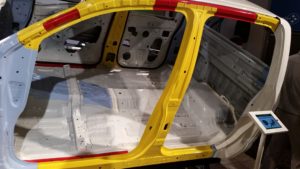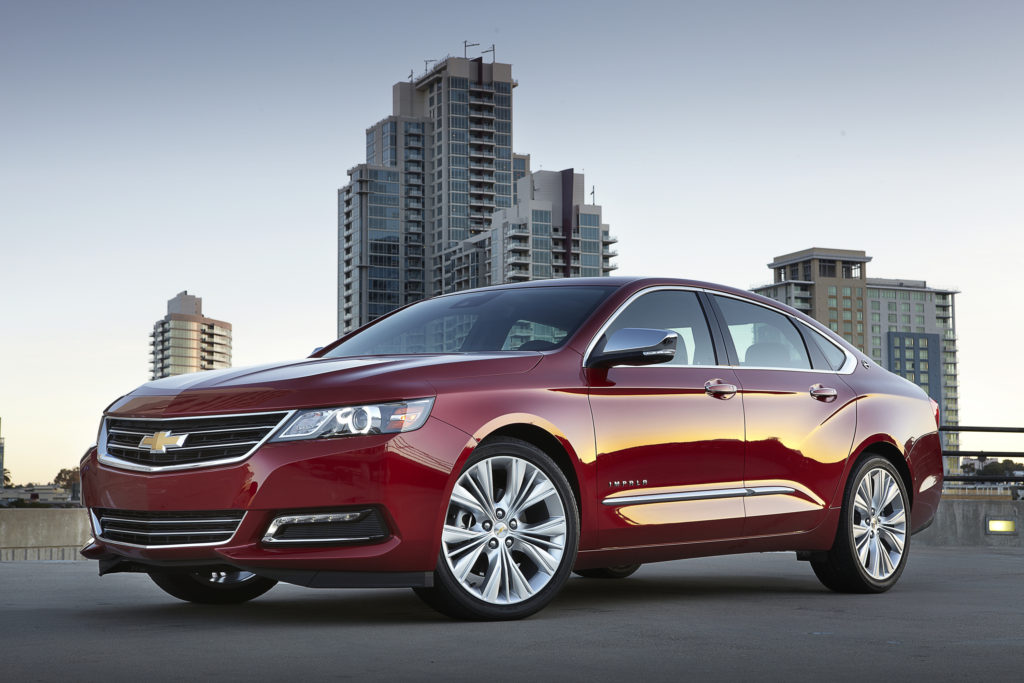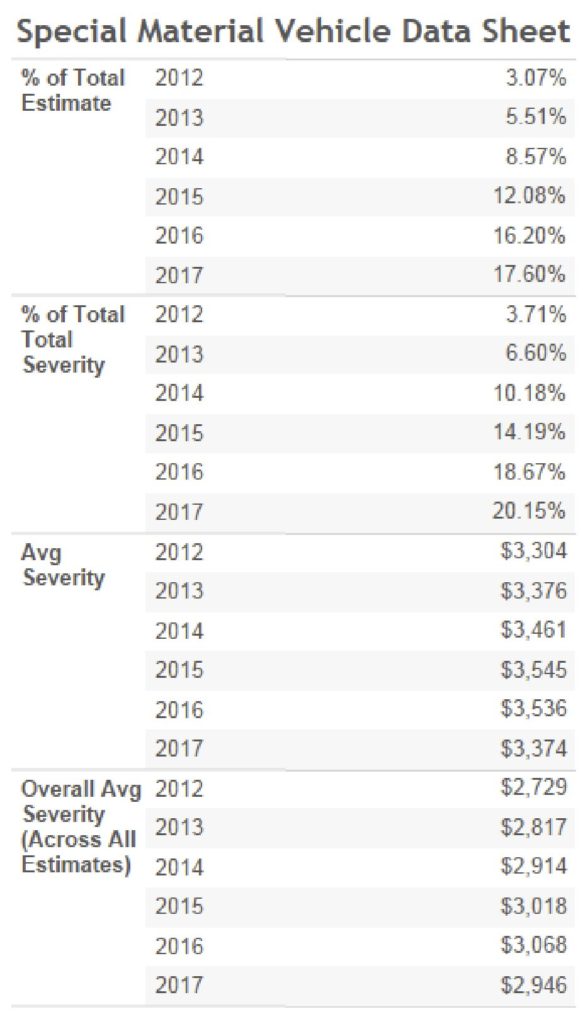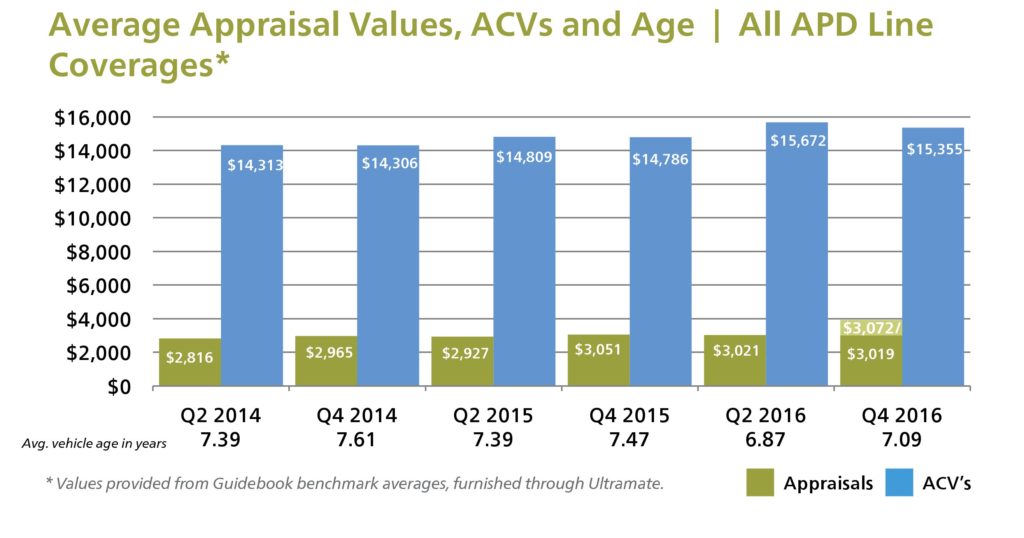
Mitchell data shows boom of ‘special materials’ on repaired cars — and accompanying severity increases
By onEducation | Market Trends | Repair Operations | Technology
Vehicles with “special materials” — such as higher-strength steels, aluminum, magnesium and carbon fiber — have exploded from 3 percent to nearly 18 percent of Mitchell’s estimates over the past five years, the company reported this month.
The data contained in Mitchell’s latest free quarterly Industry Trends Report indicates that vehicles with such substrates posted $428 higher severity than the entire fleet of cars estimated in Mitchell’s database — a 14.5 percent difference.
Severity used to be even higher on vehicles with more advanced materials, according to Mitchell’s data. In 2012, it meant paying an average of $575 more per repair compared to the average severity across all estimates.
Study author Hans Littooy, Mitchell vice president of consulting and professional services, said that while he hadn’t validated it empirically, his hypothesis for the materials-related severity drop centered around the types of vehicles sporting advanced materials.
He speculated that in 2012, estimates involving such substrates largely were for higher-end vehicles, which were being repaired in higher-end shops charging higher-end prices. By 2017, more mainstream cars contained such materials and were being taken to conventional body shops, including those in direct repair programs who’ve agreed to even lower charges with insurers.
Littooy said Mitchell’s analysis only examined “special” types of “structural materials” — which means basically everything not mild steel. Specifically in terms of steel grades, the analysis appears to have considered strengths starting at high-strength, low-alloy to be “special materials.”
He said the study’s definition of “structural materials” included not only the body-in-white but also elements like closures, panels and bumper beams which have been incorporating more materials like aluminum. However, the research didn’t count powertrain components like aluminum engines, nor did it include aesthetic elements such as carbon fiber inside a vehicle cabin.
Time lags and the future
Mitchell’s statistics about prevalence and increased severity are likely only the beginning. That’s because a) lightweighting is expected to continue and b) materials data from 2012 and 2017 estimates doesn’t really reflect 2012 and 2017 model-year cars.
The average repairable vehicle entered into fourth-quarter 2016 Mitchell estimates was 7.09 years old. Using that statistic for some rough back-of-the-napkin math suggests shops and insurers in 2012 were really working on vehicles from the 2005 model year. By 2017, collision repairers and insurers were finally working on models from 2010. By 2022, the 2015 models — including the 2015 aluminum F-150 — will be in full force in shops and things really get interesting.
To get a sense of what this time-lag means from a materials perspective, check out the differences between the 2005, 2010, and 2016 Impala through General Motors’ free body repair manual website. (The 2015 Impala manual isn’t on the site, but 2016 is part of the same design generation and will work well enough for our purposes even if it doesn’t have as nice a ring to it.)
Remember, shops and insurers are on average repairing and paying for the 2005 editions in 2012 and the 2010 models today.
- For the design generation including the 2005 Impala, GM’s repair manual doesn’t even bother to identify steels on the body-in-white. (However, the 2006-13 repair manual suggests some laminated steel, which has major repair restrictions, is on the 2005 Impala but none of the other earlier model years.)
- In the 2010 model, part of the succeeding 2006-13 generation, we see high-strength, low-alloy steel and laminated steel. While HSLA steel doesn’t carry different repair restrictions than mild steel under GM’s general steel repairability matrix, it costs more to produce because of the alloying.
- By 2016, two years into the design generation started in 2014, we’re getting not just HSLA steel, but also dual-phase and ultra-high-strength steels with more repair restrictions as well as generally even higher price tags than mild and HSLA steel.

Littooy recalled interning at a General Motors assembly plant working on the Chevrolet Caprice. He said he owns a 1969 Chevelle, and it’s “remarkable how similar” the two were from an assembly perspective — even separated by 20 years.
But 25 years after the Caprice, “you can’t even recognize” how GM was assembling its vehicles, Littooy said.
“I think that’s what catching up with the industry,” Littooy said. Even 5-10 years ago, cars were being built the same way. But within the last five years, “we’re seeing an explosion” of more technology and advanced assembly methods than ever before.
“Five years from now, who knows what it could be,” he said.
More information:
Mitchell first-quarter 2017 Industry Trends Report
Mitchell, March 2017
Genuine GM Parts body repair manual site
Images:
590-megapascal advanced high strength steel (yellow) and 980 MPa ultra-high-strength steel (red) appears on the 2016 Nissan Titan XD at Great Designs in Steel. The cab also contains 440 MPa high-strength steel. (John Huetter/Repairer Driven News)
Vehicles with “special materials” — such as higher-strength steels, aluminum, magnesium and carbon fiber — have exploded from 3 percent to nearly 18 percent of Mitchell’s estimates over the past five years, the company reported in March 2017. (Provided by Mitchell)
Mitchell fourth-quarter 2016 data on the average repairable vehicle contained in its estimates is shown. (Provided by Mitchell)
A 2016 Chevrolet Impala LTZ is shown. (Provided by Chevrolet/Copyright General Motors)


